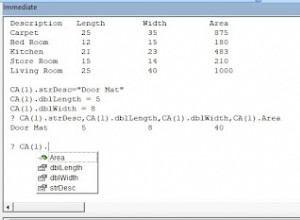Ecco una rapida query per illustrare il comportamento:
select
v,
-- FIRST_VALUE() and LAST_VALUE()
first_value(v) over(order by v) f1,
first_value(v) over(order by v rows between unbounded preceding and current row) f2,
first_value(v) over(order by v rows between unbounded preceding and unbounded following) f3,
last_value (v) over(order by v) l1,
last_value (v) over(order by v rows between unbounded preceding and current row) l2,
last_value (v) over(order by v rows between unbounded preceding and unbounded following) l3,
-- For completeness' sake, let's also compare the above with MAX()
max (v) over() m1,
max (v) over(order by v) m2,
max (v) over(order by v rows between unbounded preceding and current row) m3,
max (v) over(order by v rows between unbounded preceding and unbounded following) m4
from (values(1),(2),(3),(4)) t(v)
L'output della query precedente può essere visualizzato qui (SQLFiddle qui ):
| V | F1 | F2 | F3 | L1 | L2 | L3 | M1 | M2 | M3 | M4 |
|---|----|----|----|----|----|----|----|----|----|----|
| 1 | 1 | 1 | 1 | 1 | 1 | 4 | 4 | 1 | 1 | 4 |
| 2 | 1 | 1 | 1 | 2 | 2 | 4 | 4 | 2 | 2 | 4 |
| 3 | 1 | 1 | 1 | 3 | 3 | 4 | 4 | 3 | 3 | 4 |
| 4 | 1 | 1 | 1 | 4 | 4 | 4 | 4 | 4 | 4 | 4 |
Poche persone pensano ai frame impliciti applicati alle funzioni della finestra che accettano un ORDER BY clausola. In questo caso, le finestre sono di default sulla cornice RANGE BETWEEN UNBOUNDED PRECEDING AND CURRENT ROW . (RANGE non è esattamente lo stesso di ROWS, ma questa è un'altra storia). Pensaci in questo modo:
- Sulla riga con
v = 1la cornice della finestra ordinata si estende suv IN (1) - Sulla riga con
v = 2la cornice della finestra ordinata si estende suv IN (1, 2) - Sulla riga con
v = 3la cornice della finestra ordinata si estende suv IN (1, 2, 3) - Sulla riga con
v = 4la cornice della finestra ordinata si estende suv IN (1, 2, 3, 4)
Se vuoi prevenire questo comportamento, hai due opzioni:
- Utilizza un esplicito
ROWS BETWEEN UNBOUNDED PRECEDING AND UNBOUNDED FOLLOWINGclausola per ordinato funzioni della finestra - Non utilizzare
ORDER BYclausola in quelle funzioni della finestra che consentono di ometterle (comeMAX(v) OVER())
Maggiori dettagli sono spiegati in questo articolo su LEAD() , LAG() , FIRST_VALUE() e LAST_VALUE()




